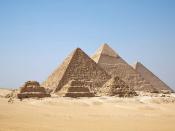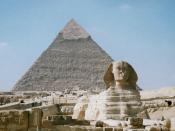Images of Power and Authority in Art
Art has been used to portray figures of power and authority many times in history.
Different cultures have different ways of portraying the image to have power and authority. One
example of using art to portray images of power and authority is the Victory Stele of Naram-Sin.
This was made to commemorate King Naram-Sin for his defeat of Lullubi. The King stands alone
at the top, taller than everyone else. This shows that he is more powerful than anyone else. The
King also wears a horned helmet that shows godliness. Celestial bodies shine upon him also
showing him as a deity. His troops are lined up behind him in an orderly fashion, showing his
control and also the discipline and organization of his forces. He and his army have complete
control of the subdued enemy, showing that he and his army are superior.
Art was also used to portray images of power and authority in the times of Ancient Egypt.
This is shown in the Statue of Khafre. On the seat Khafre is sitting in there is an image of
intertwined lotus and papyrus which symbolizes united Egypt. The falcon covering his head is
Horus, the god the sky and heavens. This implies the pharaoh's divine status. The pharaoh is
also shaped with a canon of ideal proportions, which is suitable for someone as perfect as the
pharaoh. Also the expression on the pharaoh's face is calm and shows eternal strength and life.
Many of the traits in both examples constitute how their culture's image of power and authority.
Bibliography
1) Gardner's Art Through the Ages Tenth Edition, p.50,75-76.
2) www.coco.cc.az.us/apetersen/ _ART201/old_king.htm
3) www.coco.cc.az.us/apetersen/ _ART201/akkad.htm
4) "Ancient Egypt", World Book Encyclopedia, 1990.
Images of Power and Authority in Art...


